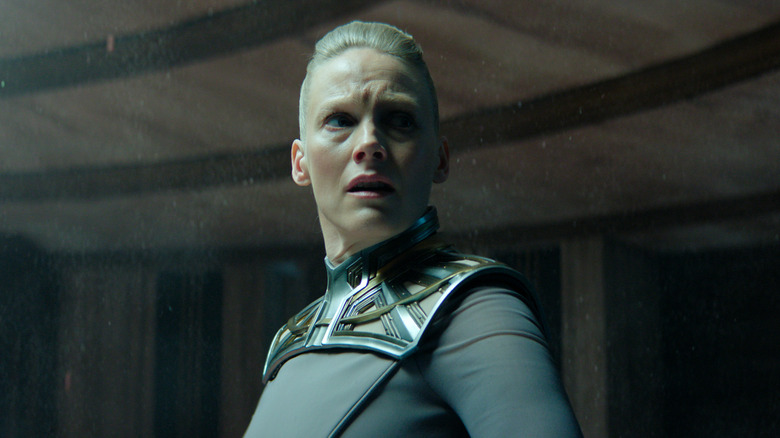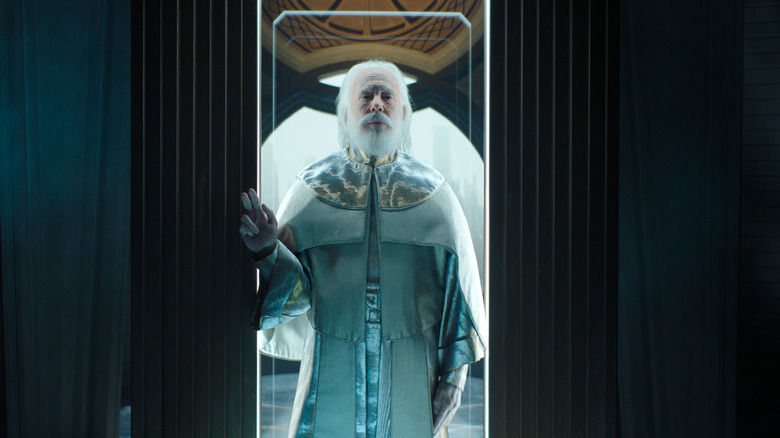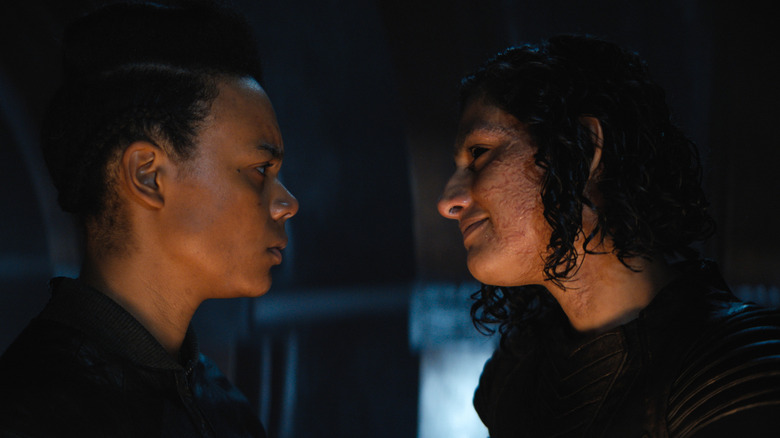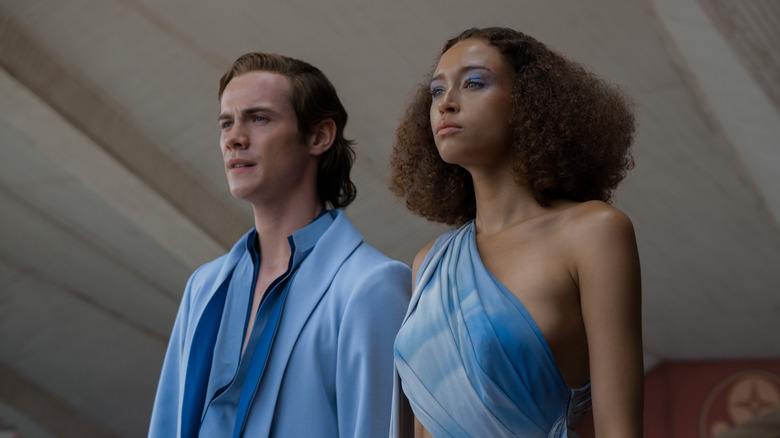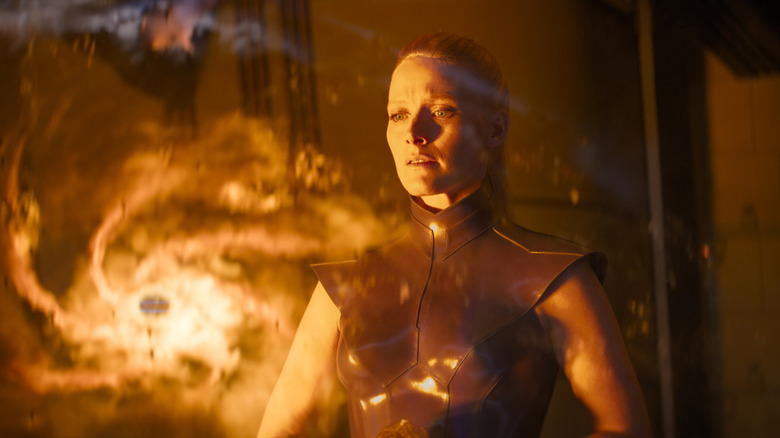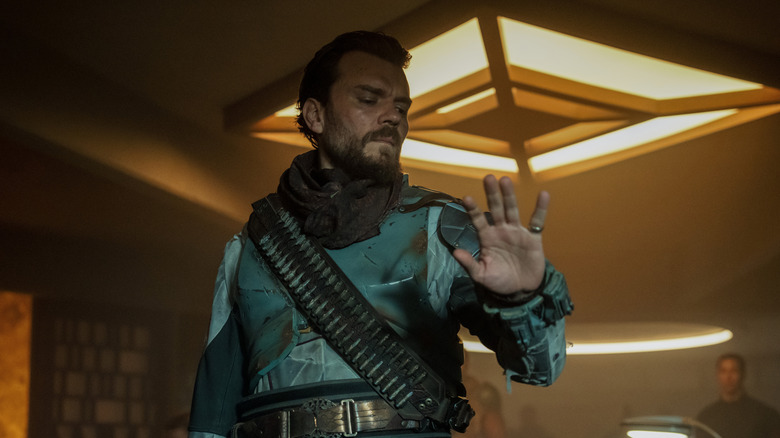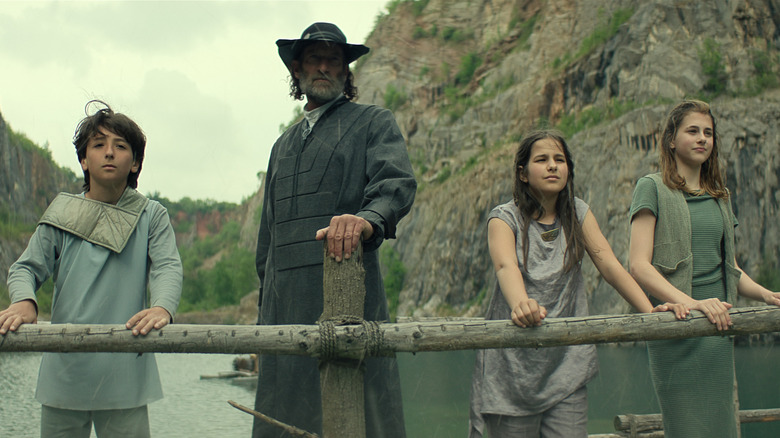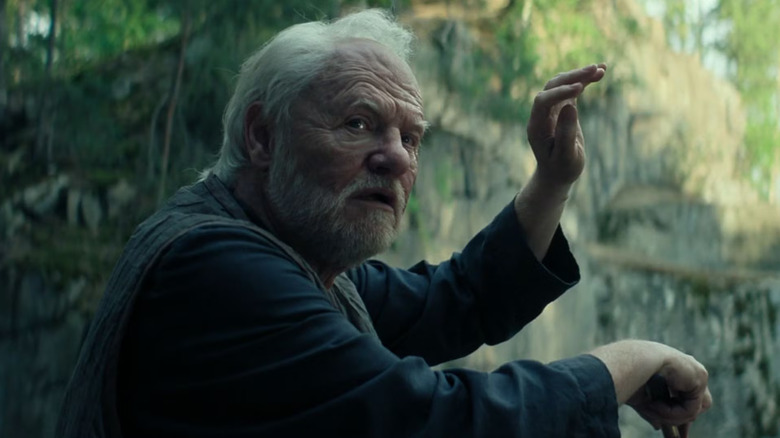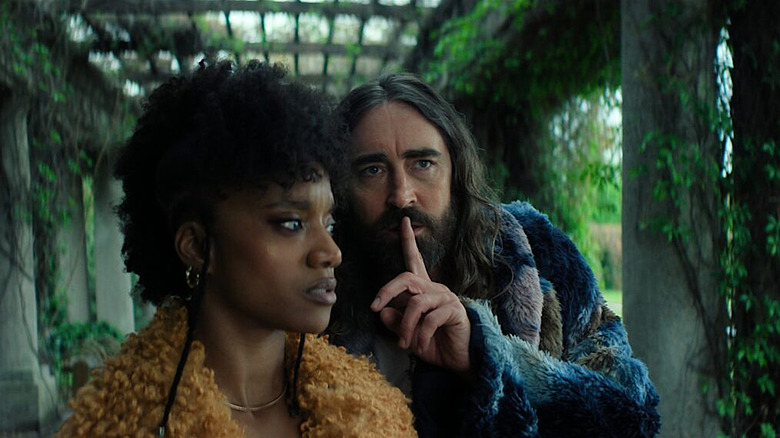The Entire Foundation Timeline Explained
Heads up! This contains spoilers for "Foundation" Season 3, Episode 10, "The Darkness."
"Foundation" season 3 just came to a climactic conclusion. A genetic dynasty improbably fell in an instant, and an unstoppable metalic mutant was overcome at the cusp of victory. Robots were heavily involved at every step, and Hari Seldon's plan appeared to potentially get back on track — though with some major caveats. There was so much going on in the season finale that it served as a reminder that this show has a lot of balls in the air. From the falling Galactic Empire to the First Foundation to the Second Foundation, there are a lot of moving parts. Some of them have been moving for all three seasons, too.
If you forgot how we got to this point, it's completely understandable. Honesty, even though I've read the books twice over and watched the show with enraptured interest, I was a little lost, too. I thought back to the simplicity of season 1. At that point, the plot was that the Galactic Empire was doomed and Hari Seldon's (Jared Harris) psychohistory (which showrunner David S. Goyer adapted with intention) was going to reduce a predicted 30,000-year "Dark Age" to a mere 500-year interlude between empires. Three seasons in, the show has exploded into so many storylines, it's hard to keep track.
Never fear! We went back and dug through the archives of the show to pull together a comprehensive (albeit time-hopping and galaxy-spanning) timeline. If you're struggling to remember how the "Foundation" storyline wound its way up to the present moment, you're in the right place. Here is a thorough but concise rundown of the entire "Foundation" timeline. I'll follow the show exclusively, but make sure to read to the end if you want to hear my final thoughts on how this all compares to the books, too. Enjoy!
Pre-Foundation History
Let's begin back at the beginning. Well, relatively "the beginning." Author Isaac Asimov connected the roots of "Foundation" way back to his "I, Robot" novel. That and his other robot books in that world are set 18,000 years earlier in the same universe. Several connections to this distant past and the interim between them have come up in the show, so let's start with a rapid-fire account of the highlights.
First, we have Demerzel's (Laura Birn) creation on Earth, approximately 18,000 years before the show and more than 6,000 years before the founding of the Galactic Empire. A few thousand years later, the religion of Luminism is formed, which will play a key role in the "Foundation" story later on. The Galactic Empire itself shows up in the year "0" of the Era Imperial (obviously). For context, that's still nearly 12,000 years before the Genetic Dynasty even begins.
The Robot Wars (which are made up for the show and don't exist in Asimov's source material) erupt just over 7,000 years into the Era Imperial, leading to over two hundred years of bloodshed — and iridium-shed, too. The Robot-less (or mostly so) Empire goes on from there, building up and maintaining its power for millennia. Around the year 11,402, the Imperial warship Invictus is lost in space, setting the stage for the season 1 climactic confrontation several hundred years later. Three hundred years after the Invictus disappears, the emperor Cleon I begins cloning himself, creating the Genetic Dynasty in the process.
Finally, in the year 12,043, Hari and Yanna Seldon first create the Prime Radiant, setting up their great life's work and creating the tool that will guide the future of humanity for centuries to come.
The Foundation is established
The backstory is a little overwhelming, but we've officially reached the beginning of the decline and fall of the Galactic Empire. We've also reached the point where the titular colony is created. This is where the show starts, and the first episode, "The Emperor's Peace," dives into the story. It shows how the Foundation is initially established.
In the year 12,067 Era Imperial (so around 24 years after creating the Prime Radiant), Gaal Dornick (Lou Llobell) leaves Synnax. She's been summoned to the imperial capital of Trantor after gaining notoriety from Seldon and his crew for solving a complicated mathematical proof called the Abraxas Conjecture (which remained unsolved for over half a millennium). She is brought by Seldon to Trantor, only to be unexpectedly arrested along with her new mentor and tried for treason.
While on Trantor in these early days, we witness the destruction of the Star Bridge (an act ultimately revealed to have been perpetrated by Demerzel). In the following years, the new colony arrives on Terminus, establishes Terminus City, and begins the Foundation Era. In transit, Hari is murdered by his son, Raych Foss (Alfred Enoch), as part of the Seldon plan. Gaal escapes conviction via an escape pod and shoots off into space.
The First Crisis: Anacreon
At this point, the First Crisis takes place. These Crises are "turning points" in the historical timeline, as predicted by Hari Seldon's psychohistory, where the math reveals a major challenge will arise that must be overcome. The first of these turning point events takes place in the year 12,092 Era Imperial. This is 31 years into the Foundation Era timeline. (There are two parallel timelines here, but we'll stick to the Era Imperial one we've been using all along for simplicity's sake.)
In the First Crisis, armed forces from a planet near Terminus called Anacreon invade under a leader called the Great Huntress Phara Keaen (Kubbra Sait). The group attacks Terminus City and tries to reuse the Invictus as a spaceship-sized battering ram they could fly directly into the imperial palace on Trantor.
Foundation Warden Salvor Hardin (Leah Harvey) leads the resistance against the Anacreon invasion. A digital replica of Hari Seldon (or something like it — the quantum science behind Hari's ongoing existence in the adaptation version is super confusing) also emerges from the Vault for the first time. He informs everyone of the Empire's role in their antagonistic fight and shares the hitherto unknown purpose of the Foundation as a way to reset the falling Galactic Empire. At this point, Salvor Hardin also learns of her origins as Gaal's daughter and leaves for Synnax in search of her younger mother.
Between the first two crises
The century and a half after the First Crisis is filled with things that set the stage for the Second Crisis. Just so we know where we are in the show, a lot of this happens after the season 1 finale and then spills over into the beginning of season 2. Let's run through the major beats for continuity's sake.
First, at this earlier point in the story, the Empire goes on as if all is normal. The Cleons continue their role as leaders of Empire. They choose concubines, appoint sub-leaders, plan marriages — like the one with the Queen of the Cloud Dominion, Sarth I (Ella-Rae Smith) — and generally act like all is fine. Of course, everything isn't fine. The Empire is in the midst of an epic, slow-motion collapse, and behind the scenes, Demerzel is hard at work trying to hold everything together for as long as possible.
The last important piece we'll mention in this Crisis interim is that General Bel Riose (Ben Daniels) also gets caught up in the politics of Empire. During this initial inter-Crisis era, he disobeys his Emperor and is exiled to the planet of Lepsis, where we'll find him again shortly.
The Second Crisis
In the year 12,240 Era Imperial, a little over a century after the previous crisis, the Second Crisis kicks off. This begins with Gaal and Salvor connecting on Synnax, discovering the Seldon Plan is off course, and starting to make plans to fix it.
Back on the Imperial capital of Trantor, Cleon survives an assassination attempt and, before long, the Empire and Foundation come to blows. Bel Riose is brought out of exile and forced to lead an assault on Terminus. In an apocalyptic showdown, the Foundation's original planet of Terminus is destroyed along with the entirety of the Imperial fleet attacking it. Things seem hopeless, but the Foundationers manage to survive the attack via the Vault. They resettle on another planet, fittingly (and boringly) called New Terminus, where they maintain their purpose and keep their hopes alive.
This is also the point where the Second Foundation is founded on Ignis. This is the group that uses the fledgling art of mentalics to control and alter other people's minds. Initially, Hari and Gaal discover mentalics living on Ignis and after they defeat their leader, they use their fledgling colony to establish a new psychohistoric haven as a counterpoint and support piece to the First Foundation. (For the record, from this point forward, we'll refer to the First and Second Foundations by those specific titles for clarity.) With the Second Foundation up and running, Hari and Gaal start cryosleeping, only waking up for a few weeks a year to teach psychohistory to their new pupils.
Another mid-crisis period
We've now reached the second mid-crisis period. This time, the period between the Second Crisis and the Third Crisis is longer, lasting around a century and a half. We see bits of it in the early episodes of season 3, but most of the important things happen between seasons.
The biggest change is that during this time, the First Foundation reestablishes itself on the planet New Terminus and comes back bigger and better than ever. It ditches its religious roots and shifts into a commercial and expansionistic stage. Its people build up a military and it starts to show the first signs of being a genuine candidate for an Empire replacement. First Foundation amasses power so quickly that its leading figures — from groups like the Alliance of Traders and the leading house of Indburs — are lulled into a false sense of security. They become intoxicated by their own inevitability, and in that ultimate comfort, they resort to infighting and become less aware of the larger galaxy around them.
Outside of the First Foundation bubble, it's during this inter-season, inter-crisis period that the Second Foundation builds up its strength, too. After tricking Gaal into cryosleeping for a longer chunk of time, Hari stays awake and unfrozen for much of this period to figure out the impending Third Crisis and beyond.
Toward the end of the century and a half, one more important character shows up. The Mule (Pilou Asbæk) begins to rise in power. His goal? The conquest of the entire galaxy, the end of the Empire, snuffing out the First Foundation, and most importantly, discovering the Second Foundation and ending the Seldon Plan.
The Third Crisis - Part 1: Setting the Stage
Here we are, at the Third Crisis. This is the biggest crisis of them all — or at least of the first three. (There's a lot more crisis-like drama ahead if the books have anything to say on the matter.) This one is big, though, because it centers on one figure above all others, the Seldon Plan-altering, mind-controlling mentalic called the Mule. The Mule comes from interesting origins (which differ if you're watching the show or reading the source material), and he comes out of nowhere to alter the fabric of galactic politics and civilization, sparking the big, bad Third Crisis in the process.
The devastating event begins with Gaal reawakening and Hari Seldon officially dying (again). This time, Seldon leaves his protégé with a fresh armament of Prime Radiant information to lead the Second Foundation to war against the Mule — and beyond to whatever massive, Empire-ending disturbance comes next. Armed with Hari's guidance and fueled by his sacrifice, Gaal and the Second Foundationers take the fight to the Mule. Before we trace that showdown in the timeline, though, we need to catch up the myriad of other storylines taking place around this point in time.
The Third Crisis - Part 2: Empire, Foundations, and the Mule
Before Gaal and company show up to take down the Mule, the villain has ripped a geopolitical hole through the galaxy. He starts by taking over the pleasure planet of Kalgan and positioning himself as a new warlord with extraordinary powers. Before long, he takes his fight straight to the heart of the Foundation, where he hamstrings the entire planet with his mind-bending abilities, turning the First Foundationers against themselves and making them his desperately loyal servants.
Meanwhile, back on Trantor, the Empire enters its terminal phase. Brother Dusk (Terrence Mann) faces his regularly scheduled termination with trepidation. As he becomes Brother Darkness and is about to be ceremoniously executed, he turns on his cloned brethren and their positronic master. Brother Darkness wipes out the genetic dynasty, killing his living and undecanted brothers en masse, and destroys Demerzel, to boot. At least, he destroys her body. However, just before this dynasty-ending drama, Brother Day (Lee Pace) delivers a robot relic to Demerzel, allowing her to Clasp with it and maintain her existence, even if her body is disintegrated.
With Empire in tatters and the First Foundation subjugated, the last hope for Seldon's Plan to guide humanity through the Third Crisis becomes Gaal and the Second Foundation. The group travels to New Terminus, where they find the Mule waiting in a ship hovering above the planet.
In the subsequent attack, it's revealed that the Mule isn't the man we thought he was. It's actually Bayta (Synnøve Karlsen) — a shocking twist from the books, where Magnifico Giganticus is the Mule in disguise and Bayta is the one person who is able to stop him from getting what he wants. Once Bayta is revealed as the true antagonist, she is defeated in an epic mentalic battle with Gaal and the Second Foundationers.
What's to come in the Foundation Timeline
This is where season 3 wraps up. As far as Apple TV+'s impressive sci-fi show is concerned, the story doesn't go much further — yet. But we do have a few hints of what's in store for the next phases of the Asimov adaptation.
First, there's the closing scene of season 3. This reveals that other robots, led by Kalle (Rowena King), are living in an underground base on the Moon near Earth. This is a huge nod toward the end of the story, and it hints at the fact that, even in the depths of despair in a conflict like that with the Mule, there is a bigger picture project at work, driving humanity toward its future.
The other futuristic predictions come earlier in season 3, when Hari Seldon tells Gaal about the next crisis after the Mule. While he isn't able to be clear about what is coming, less than a couple of centuries in the future, another, bigger disrupting event is clearly in store for the Foundations. It seems to connect to the final fall of the Empire and, based on the math we see in the Prime Radiant, will make the Mule feel like small potatoes. There's a lot more to come if this show can run for two or three more seasons.
What are the actual Crises in the books?
Before we wrap up here, one more fun little exercise. Let's look at how the three Crises in the show compare to their counterparts in the books. A couple of years ago, we detailed what the crises look like in Asimov's printed pages. Here's the updated, TL;DR version of that copy, considering everything we learned in season 3.
For starters, the Crises occur more often and are less epic in the books. By the time the Empire goes to war with the First Foundation in season 2, the Seldon Plan has faced and overcome four different crisis points. These are closer together, too. The first two, for instance, happen within about 30 years and both within the lifespan of Salvor Hardin.
It's also worth pointing out that the involvement of Hari Seldon and the Prime Radiant is much less pronounced in the books. Gaal isn't even a factor. Rather than influence and set up for each crisis, a pre-recorded hologram of Seldon appears before or after an event to talk about the likelihood of the event happening and the chance that the Foundation survived it. For instance, when the Empire attacks in the Fourth Crisis, Hari's pre-recorded report says:
I have few fears as yet of a breakdown in the Plan. For the first three centuries the percentage probability of nondeviation is nine-four point two.
As time goes on (think season 3 of the show), other factors prove to have a much lower probability of success, and the Mule is a more or less unexpected deviation. Other Crises will follow the Mule in the now greenlit season 4, but don't expect the same level of predictability. Their cadence and alignment with the Seldon Plan become much less obvious moving forward as other individuals, groups, and factors take center stage.
